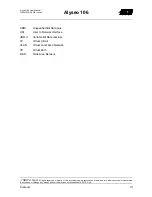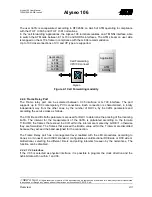
Alyseo 106
SELTA S.p.A
.
All rights reserved. No parts of this document can be reproduced, memorized into archive system or transmitted
in any shape or through any means without the previous authorization of SELTA S.p.A.
Overview
2-5
Alyseo 106 User Manual
720041008-A0-GB Issue 4
In the service interworking application, the translation of the InARP and ARP packets is performed
(both the messages of ‘request’ and ‘reply’ type) from Frame Relay format to ATM format and
viceversa, according to what specified by the FRF.8.1 recommendations and with format in
compliance with RFC2225. This functionality allows the updating of the ATM table on the access
router recording the IP addresses of the remote interfaces (target) solved through the InARP
protocol.
2.2.5.2 Network interworking
The Network Interworking Function foresees the one-to-one connections, where a single Frame
Relay logic connection (identified by DLCI) is mapped on a single ATM connection (PVC), and the
many-to-one connections, where more Frame Relay connections are mapped on a single PVC
ATM.
In case of one-to-one connections in NIW modality, it is possible to configure the ‘DLCI switching’
functionality in upstream direction; in this modality the DLCI on user side can be translated to a
different DCLI on network side.
In downstream direction, only in case of one-to-one connections, all the DLCIs with value between
1 and 1022 are translated to the DLCI on user side.
Figure 2-3 Encapsulation of the protocols in Interworking network modality
2.2.5.3 Fault management protocols
Besides the management of the Link Integrity Verification procedure, foreseen by the FRF.5
specification as previously indicated (paragraph 2.2.5), the "Troubleshooting PVC Failures When
Using OAM Cells and PVC Management" proprietary CISCO protocol is supported in
programmable way for each logic connection. This implementation allows activating the backup
lines by the connected router, in case of fault (for the configuration, see chapter 4).
The check of the link is made sending periodically, from one end point to the other, OAM cells of
loopback type. Each termination answers to the loopback cells and waits for the answer of the
other terminal; proper timeouts allows detecting possible faults on the network and relating
properly to the LMI protocol of the frame relay, which indicates to the user router the status of the
connections.
Application
Q.922
Core
V.35/G.703
DTE
Application
FR SSCS
CPCS
SAR
Q.922
Core
ATM
V.35/G.703
SHDSL
Alyseo
ATM ATM
SHDSL
ANY
phy
DSLAM
ATM
network
Application
FR
SSCS
CPCS
SAR
Q.922
Core
ATM
V.35/G.7
03
SHDSL
Alyseo
Application
Q.922
Core
V.35/G.703
DTE
Remoto
Summary of Contents for Alyseo 106
Page 1: ...User Manual Alyseo 106 ...
















































